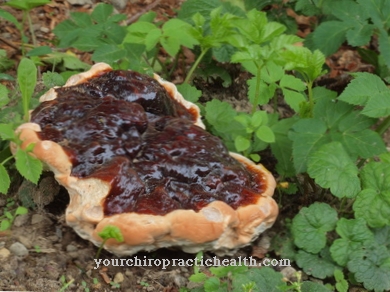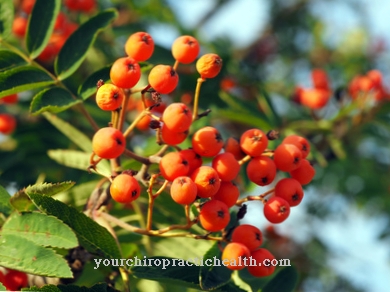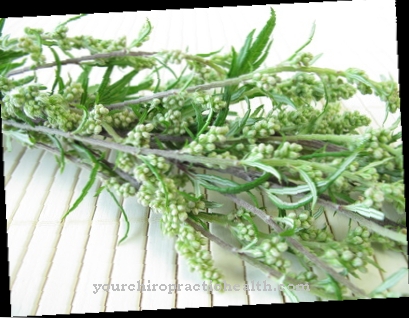The Bell heather or Bog-bell heather belongs to the heather family and is also under the name Bog heather, Spring heather or Toppheide known.
Occurrence and cultivation of bell heather

Bell heather is very similar to Irish heather or snow heather, except that the stylus and stamens are hidden. This could also be an indication that the plant mainly unfolds its effect on extensive diseases. The flowering time of the bell heather is between June and September. After pollination, the corolla is preserved, so it looks like the plant is blooming for a long time.
Spontaneous self-pollination is very common, whereas bell heather is relatively rarely pollinated by butterflies, bumblebees or bees. The main pollination is carried out by the so-called thunderstorm worms, insects that belong to the group of bladder feet. The eggs are laid by the females in the petals, where the larvae subsequently develop. The adult insects can also be found in the flowers, mostly winged females.
The fruits of the bell heather are hidden in the crown. They are dry capsules, the seeds of which are very small. The heather family is found mainly in Portugal, Spain, Denmark, England and northern France. It is also growing in part in Poland and in the north-west German lowlands. The bell heather mainly prefers bog forests, grass grass and dwarf shrub heaths, where the soils are poor in nutrients, acidic and peaty.
In addition, it also settles on the banks of heather bogs, heather ponds, in forest clearings or in sand pits. So-called bog heaths are formed especially on rain moor locations that have been partially drained. Due to drainage and reforestation, the plant is already endangered in many places and larger stands can very often only be found in nature reserves. As an ornamental plant, bell heather grows without any problems on nutrient-poor garden soils.
It thrives very well in bright locations without direct sunlight. If there is too much sun, the flowers dry out very quickly and then fall off. Nevertheless, caring for the bell heather is relatively uncomplicated. It is best to use lime-free water for watering, as the plant is quite sensitive to lime. If the temperatures drop below minus five degrees, the bell heather freezes to death. Therefore, before the first frost, it should be stored in a place with three to ten degrees.
Effect & application
Bell heather has an antipyretic, anti-inflammatory, expectorant and cancer preventive effect and is used for bronchitis, bladder diseases, cough and fever, but also against colon cancer. The inhabitants of many wetlands used the plant earlier for illnesses that were associated with fever. They also ate the shoots as vegetables or ate the flowers with their vitamin and protein-rich pollen.
Well-known doctors such as Pietro Matholi and Hieronymos Bock also praised bell heather as a remedy. The heather plants are used less as a single remedy, but rather in a balanced recipe. Bell heather contains arbutin, ursolic acid, saponins and flavones. Urolic acid is an anti-inflammatory agent, and the same applies to the active ingredient arbutin or its breakdown product hydroquinone, which is the main active ingredient in many medicinal plants used for urinary tract diseases.
Hydroquinone shows its antibacterial effect especially in infections of the urinary system. In higher doses, arbutin causes vomiting and nausea, is carcinogenic, mutagenic and damaging to the liver. For this reason, remedies containing arbutin are contraindicated during pregnancy or while breastfeeding. Nevertheless, hydroquinone and arbutin have a very good effect on escherischia bacteria. In addition, bell heather contains oleanolic acid, which is used in chronic renal insufficiency, campesterol, cholesterol, sitosterol, stigmasterol and sitostaniol. However, these ingredients are only found in low concentrations.
Importance for health, treatment & prevention
To make tea, one to two teaspoons of the dried flowers are poured over with hot water. The drink has to steep for a few minutes before it is strained and used for fever and inflammation. It also helps with coughing up and colon cancer. A honey is also produced from the bell heather, which is very dark and has an extremely strong taste. Bell heather is also available as a flower essence, which is supposed to help you appear bold and develop more self-esteem.
To do this, put two drops of the essence in an amber glass bottle with a pipette insert and fill it up with 1/4 cognac and 3/4 water. 4x4 drops are then taken daily. In very acute conditions, two drops of the flower essence are put into a glass of water, which is then to be drunk in sips throughout the day. Externally, the plant can also be used for an envelope. For this, the cooled tea is used, with which a compress is soaked. This can then be placed on eczema or an inflamed area of skin.

























.jpg)


